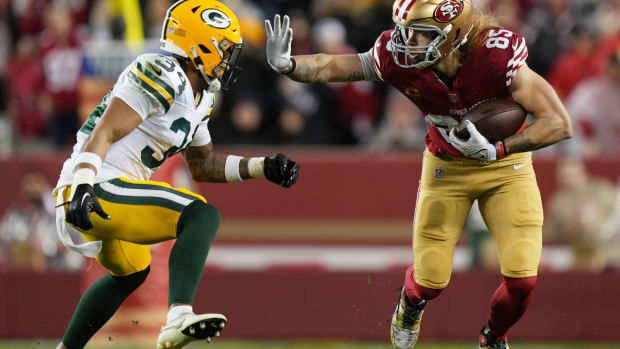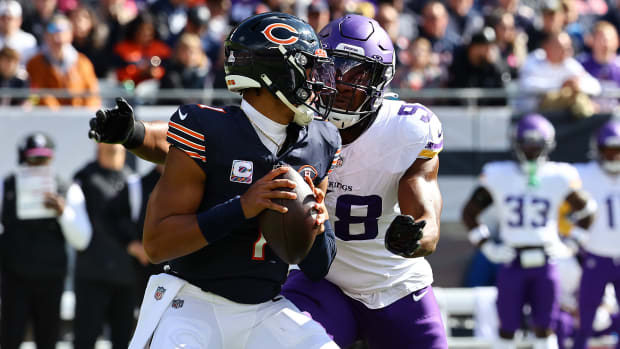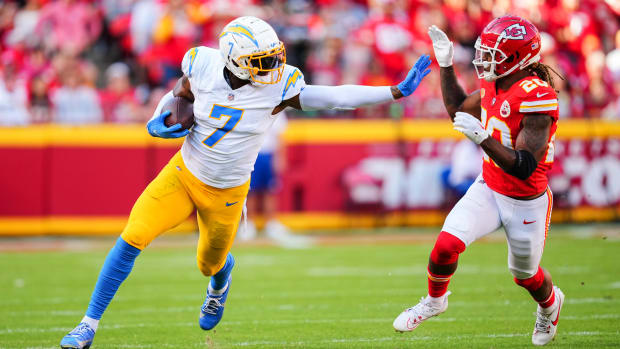How Second-Half Slate Offers Bears Offense Breathing Room
It would be easy to dismiss the chances the Bears have in the season's second half based on what their numbers say they've done to date on offense, chiefly at running the ball.
A season isn't drawn up on paper, classified and coalated. It's not as simple as numbers and rankings.
The injuries facing the Bears on the offensive line say this much.
However, it's not a game of solitaire. It's not played against a computer. When a team plays another one, the injuries, the adjustments made and the human element enter into it. The other team's strengths figure in as well.
Still, based on what the Bears have been through offensively there is reason to think they've reached a clearing, and before them is a chance to cut loose. It's not like reaching the interstate after driving through a crowded city, but the traffic is more sparce.
Much of this has to do with their offense, who they've faced with Nick Foles at quarterback and who they must still play.
With Foles starting at quarterback, the Bears have faced the No. 1 defense (Rams), the No. 2 defense (Colts), the No. 3 defense (Buccaneers), the No. 8 defense (Saints) and the No. 15 defense (Panthers).
It's been a difficult gauntlet of defenses, and the biggest problem the Bears have had in the stretch has been mounting a running attack to take pressure off the passing attack.
To this point, the Bucs are No. 1 against the run, the Colts No. 2, the Saints No. 3, the Rams No. 4 and the Giants No. 8.
The only team in that five-team group the Bears ran against was the Giants and it was with Mitchell Trubisky at quarterback, which allowed them more opportunity to run because his threat as a runner in the zone-read kept defensive ends in check and gave David Montgomery more of an initial clearing. The Bucs, Colts, Saints and Rams are not one-trick defenses. They aren't ranked highly against the run because everyone automatically passes against porous secondaries. They have sound enough defenses to challenge offenses across the board.
The cynic would look at the ranking of those run defenses and say they're only ranked so high against the run because they've played against the Bears and their anemic running attack. This would be a false statement, because those teams all had highly ranked run defenses even without their game against the Bears.
Remember, we're at the halfway point to the season so the sample size is large enough that one game didn't pollute the statistical pool.
You have to think Foles is going to have more of a dual-threat attack at his disposal in the second half, and giving Foles the run or pass can pose danger to any defense.
Even with a makeshift offensive line in front of him, Foles did enough to get the Bears to overtime against the 5-2 Saints.
Ahead, the Bears do not face a single team ranked higher than 15th against the run.
They play four games against the Packers and Vikings, who are 15th and 19th respectively. Those are by far the best run defenses they face. The rest, including Tennessee (22nd) this week, are ranked close to or in the bottom third of the league.
There's the clearing.
And now for the tricky part.
The Bears' own defense has to find a way to become more stout against the run or they can offset any benefits the offense derives from playing against weaker run defenses.
The Bears defense leaked against the run throughout the first half and played running attacks slightly above NFL average.
There have been three top-10 rushing attacks in the group.
In the second half they're going against five running attacks already ranked in the top 10—Minnesota (6th) twice, Green Bay (9th) twice and Tennessee (4th).
If you're taking how opponents have fared so far into account, then weighing in the injuries the Bears have on their offensive line, chances appear far greater for a 3-5 or 4-4 second half by the Bears. That's only going to put them where they were last year at .500 or at 9-7.
The difference between 8-8 and 9-7 could keep them out of the playoffs even in the new expanded playoff pool.
Twitter: BearDigest@BearsOnMaven




